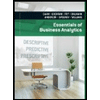
AUDITING+ASSURANCE SERVICES (LL)
11th Edition
ISBN: 9781266448119
Author: MESSIER
Publisher: MCG
expand_more
expand_more
format_list_bulleted
Concept explainers
Question
Chapter 9, Problem 9.22P
a
To determine
Introduction:
Monetary Unit Sampling (MUS): It is a method used to gauge the amount of misstatement in financials. MUS helps auditors to overcome difficulties in other sampling systems. MUS is normally used for testing accounts related to monetary assets.
The
b
To determine
Introduction:
Monetary Unit Sampling (MUS): It is a method used to gauge the amount of misstatement in financials. MUS helps auditors to overcome difficulties in other sampling systems. MUS is normally used for testing accounts related to monetary assets.
The Upper misstatement limit UML for the following misstatements.
Expert Solution & Answer
Want to see the full answer?
Check out a sample textbook solution
Students have asked these similar questions
finance qn
None
None
Chapter 9 Solutions
AUDITING+ASSURANCE SERVICES (LL)
Ch. 9 - Prob. 9.1RQCh. 9 - Prob. 9.2RQCh. 9 - Prob. 9.3RQCh. 9 - Prob. 9.4RQCh. 9 - Prob. 9.5RQCh. 9 - Prob. 9.6RQCh. 9 - Prob. 9.7RQCh. 9 - Prob. 9.8RQCh. 9 - Prob. 9.9RQCh. 9 - Prob. 9.10RQ
Ch. 9 - Prob. 9.11MCQCh. 9 - Prob. 9.12MCQCh. 9 - Prob. 9.13MCQCh. 9 - Prob. 9.14MCQCh. 9 - Prob. 9.15MCQCh. 9 - Prob. 9.16MCQCh. 9 - Prob. 9.17MCQCh. 9 - Prob. 9.18MCQCh. 9 - Prob. 9.19MCQCh. 9 - Prob. 9.20MCQCh. 9 - Prob. 9.21PCh. 9 - Prob. 9.22PCh. 9 - Prob. 9.23PCh. 9 - Prob. 9.24PCh. 9 - Prob. 9.25PCh. 9 - Prob. 9.26P
Knowledge Booster
Learn more about
Need a deep-dive on the concept behind this application? Look no further. Learn more about this topic, finance and related others by exploring similar questions and additional content below.Similar questions
- Muskoka Tourism has announced a rights offer to raise $30 million for a new magazine, titled ‘Discover Muskoka’. The magazine will review potential articles after the author pays a nonrefundable reviewing fee of $5,000 per page. The stock currently sells for $52 per share and there are 3.9 million shares outstanding. Required What is the maximum possible subscription price? What is the minimum? If the subscription price is set at $46 per share, how many shares must be sold? How many rights will it take to buy one share? What is the ex-rights price? What is the value of a right?arrow_forwardNorthern Escapes Inc. has 225,000 shares of stock outstanding. Each share is worth $73, so the company’s market value of equity is $16,425,000. Suppose the firm issues 30,000 new shares at the following prices: $73, $69, and $60. What will the effect be of each of these alternative offering prices on the existing price per share?arrow_forwardNeed answer correctly.arrow_forward
- Muskoka Tourism has announced a rights offer to raise $30 million for a new magazine, titled ‘Discover Muskoka’. The magazine will review potential articles after the author pays a nonrefundable reviewing fee of $5,000 per page. The stock currently sells for $52 per share and there are 3.9 million shares outstanding.arrow_forwardSs stores probarrow_forwardHenrietta’s Pine Bakery Corporation would like to raise $75 million to finance its expansion into new markets. The company will sell new shares of equity via a general cash offering to raise the needed funds. If the offer price is $15 per share and the company’s underwriters charge a 6% spread, how many shares need to be sold?arrow_forward
arrow_back_ios
SEE MORE QUESTIONS
arrow_forward_ios
Recommended textbooks for you
 Auditing: A Risk Based-Approach (MindTap Course L...AccountingISBN:9781337619455Author:Karla M Johnstone, Audrey A. Gramling, Larry E. RittenbergPublisher:Cengage Learning
Auditing: A Risk Based-Approach (MindTap Course L...AccountingISBN:9781337619455Author:Karla M Johnstone, Audrey A. Gramling, Larry E. RittenbergPublisher:Cengage Learning Auditing: A Risk Based-Approach to Conducting a Q...AccountingISBN:9781305080577Author:Karla M Johnstone, Audrey A. Gramling, Larry E. RittenbergPublisher:South-Western College Pub
Auditing: A Risk Based-Approach to Conducting a Q...AccountingISBN:9781305080577Author:Karla M Johnstone, Audrey A. Gramling, Larry E. RittenbergPublisher:South-Western College Pub Essentials Of Business AnalyticsStatisticsISBN:9781285187273Author:Camm, Jeff.Publisher:Cengage Learning,
Essentials Of Business AnalyticsStatisticsISBN:9781285187273Author:Camm, Jeff.Publisher:Cengage Learning,

Auditing: A Risk Based-Approach (MindTap Course L...
Accounting
ISBN:9781337619455
Author:Karla M Johnstone, Audrey A. Gramling, Larry E. Rittenberg
Publisher:Cengage Learning

Auditing: A Risk Based-Approach to Conducting a Q...
Accounting
ISBN:9781305080577
Author:Karla M Johnstone, Audrey A. Gramling, Larry E. Rittenberg
Publisher:South-Western College Pub

Essentials Of Business Analytics
Statistics
ISBN:9781285187273
Author:Camm, Jeff.
Publisher:Cengage Learning,